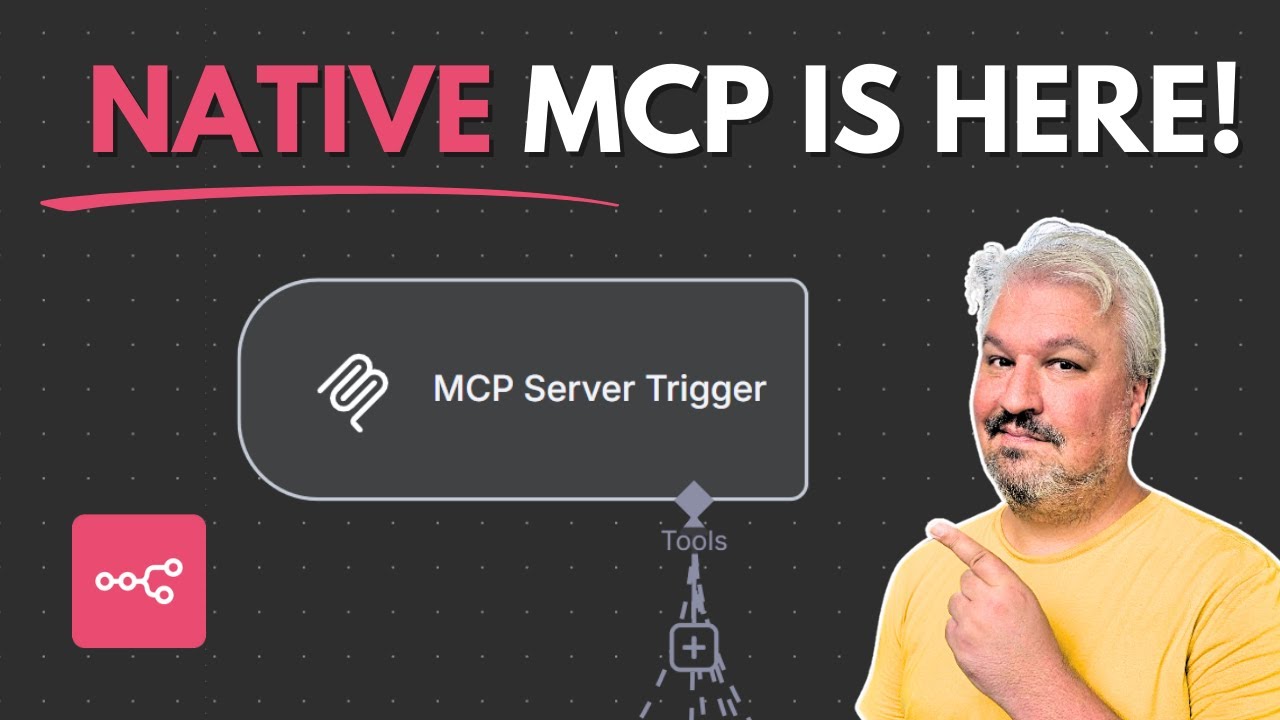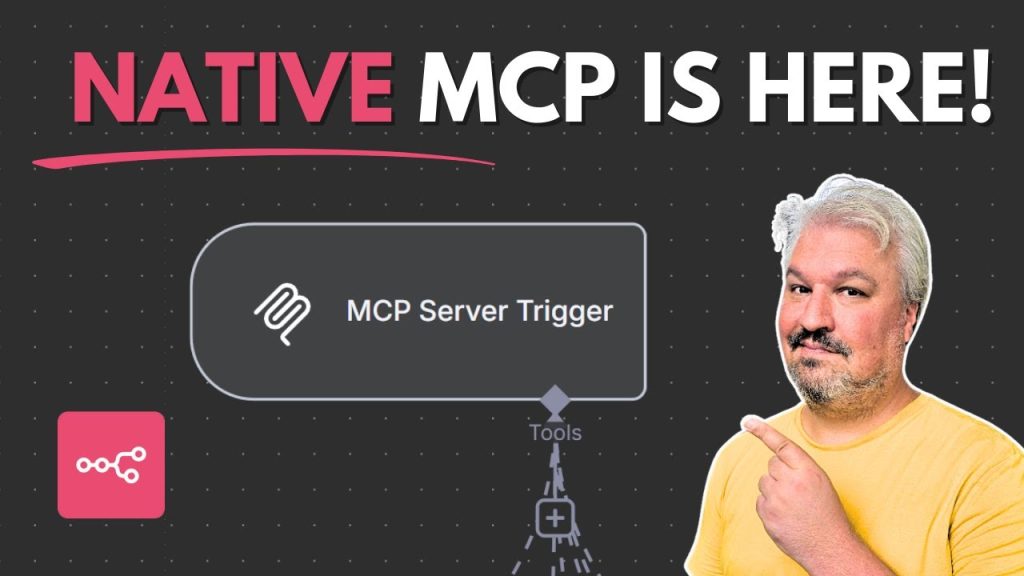Based on a tutorial by Leon van Zyl
If you’ve been struggling with the Model Context Protocol (MCP) community nodes in n8n – dealing with crashes, complex setups, and hardware-intensive requirements – you’re not alone. Many users have faced these exact challenges when trying to integrate MCP functionality.
The good news? n8n has just released native MCP support that changes everything. No more unreliable community nodes or server crashes. In this comprehensive summary of Leon van Zyl’s tutorial, I’ll walk you through both creating MCP servers and using n8n as an MCP client, plus share some practical examples you can implement today.
Quick Navigation
What Changed with Native MCP Support

Before this update, integrating MCP with n8n was frankly a nightmare. The community nodes were resource-heavy, unreliable, and caused frequent crashes. Leon’s own self-hosted n8n instance kept crashing due to these insane requirements.
With native support, you can now:
Key Capabilities:
- Build MCP servers directly in n8n – Create custom tools that integrate with AI applications
- Use n8n as an MCP client – Connect to existing MCP servers seamlessly
- Integrate with popular AI tools – Works with Claude Desktop, Cursor, and other MCP-compatible applications
- Stable performance – No more crashes or hardware intensity issues
My Take:
This is a game-changer for n8n users. The ability to create stable, lightweight MCP integrations opens up countless automation possibilities that were previously too complex or unreliable to implement.
Setting Up Your First MCP Server
Creating an MCP server in n8n is surprisingly straightforward. Here’s the step-by-step process that Leon demonstrates:
Setup Steps:
- Create a new workflow in n8n
- Add the MCP Server trigger as your first node
- Configure authentication (bearer token, header auth, or no auth)
- Add tools to your MCP trigger
- Save and activate the workflow
The MCP server trigger provides both test and production URLs. Leon recommends starting simple – even a basic calculator tool can help you understand the workflow.
Example MCP Server Configuration:
{
"mcpServers": {
"n8n-tutorial": {
"command": "npx",
"args": ["-y", "@n8n/mcp-server"],
"env": {
"N8N_MCP_SERVER_URL": "https://your-n8n-instance.com/webhook/mcp/tutorial"
}
}
}
}
Pro Tip:
Start with simple tools first. Once you see how the MCP server responds to basic requests, you’ll better understand how to structure more complex workflows.
Integrating with Claude Desktop & Cursor
One of the most powerful aspects of n8n’s MCP implementation is how easily it integrates with popular AI development tools.
Claude Desktop Setup
To connect your n8n MCP server to Claude Desktop:
- Download Claude Desktop from claude.ai/download
- Go to File → Settings → Developer
- Click “Edit Config” to open the configuration file
- Add your n8n MCP server configuration
- Save and restart Claude Desktop
Cursor Integration
For Cursor users (which Leon personally prefers), the process is even simpler:
- Open Cursor and go to File → Preferences → Cursor Settings
- Navigate to the MCP section
- Click “Add new global MCP server”
- Paste your n8n server endpoint
- Refresh to see available tools
Once connected, you’ll see your n8n tools appear in the AI assistant’s available functions. The integration is seamless – Claude or Cursor will automatically request permission before using your tools.
Building Practical Tools (Todo Lists & Content Generation)
Leon demonstrates two powerful real-world examples that showcase the potential of n8n MCP servers.
Todo List Management with Airtable
This example connects your MCP server to an Airtable base for todo management:
Required Tools:
- List Todos: Retrieves all items from Airtable with name and completion status
- Add Todo: Creates new todo items (automatically sets completed to false)
- Update Todo: Modifies existing items, including marking as complete
The beauty of this setup is that you can now ask Claude or Cursor natural language questions like “What are my current todos?” or “Add wash the car to my todo list and mark call mom as complete.”
Content Generation Workflow
Leon’s content generator demonstrates how to call sub-workflows within your MCP server:
Content Generator Structure:
Workflow: Social Media Post Generator
├── Trigger: "When executed by another workflow"
├── Input: Query field (string type)
├── AI Agent Node: Processes the query
└── Output: Generated social media content
This approach lets you build modular, reusable components that can be called from your MCP server, making complex AI workflows manageable.
My Take:
The sub-workflow approach is brilliant for organization. You can build a library of specialized AI tools and then expose them through a single MCP server interface.
Using n8n as an MCP Client
Beyond creating servers, n8n can also consume MCP servers created elsewhere. This opens up interesting possibilities for agent-to-agent communication.
Setting Up MCP Client Tools
Leon shows how to add MCP functionality to existing n8n agents:
- Add an MCP Client Tool to your AI agent workflow
- Configure the endpoint to point to your MCP server
- Choose to include all tools or select specific ones
- The agent can now call any available MCP tools during conversations
This creates a powerful feedback loop where your n8n agents can interact with tools from your own MCP servers or external ones.
Practical Application:
Imagine building specialized MCP servers for different business functions (CRM, content, analytics) and then having a master agent that can call tools from any of them based on user requests.
Current Limitations & Smart Workarounds
While n8n’s native MCP support is impressive, Leon points out some current limitations and shares a clever workaround.
SSE Endpoint Limitation
Currently, n8n’s MCP client can only connect to SSE (Server-Sent Events) endpoints. This means you can’t use many of the NPX-based MCP servers available in the community.
The Zapier Workaround
Here’s where Leon shares a “funny trick” that’s actually quite brilliant:
How to Access Zapier’s MCP Server:
- Visit zapier.com/mcp
- Click “Get Started” to access their SSE endpoint
- Copy the provided URL
- Add it to your n8n MCP client configuration
- Choose from thousands of Zapier integrations
While Zapier is technically n8n’s competition, this integration gives you access to connectors that might not be available in n8n yet. It’s a pragmatic solution that demonstrates the flexibility of the MCP protocol.
My Take:
This workaround shows the power of open protocols. Even competing platforms can work together when they support the same standards. It’s a win for users who just want to get things done.




